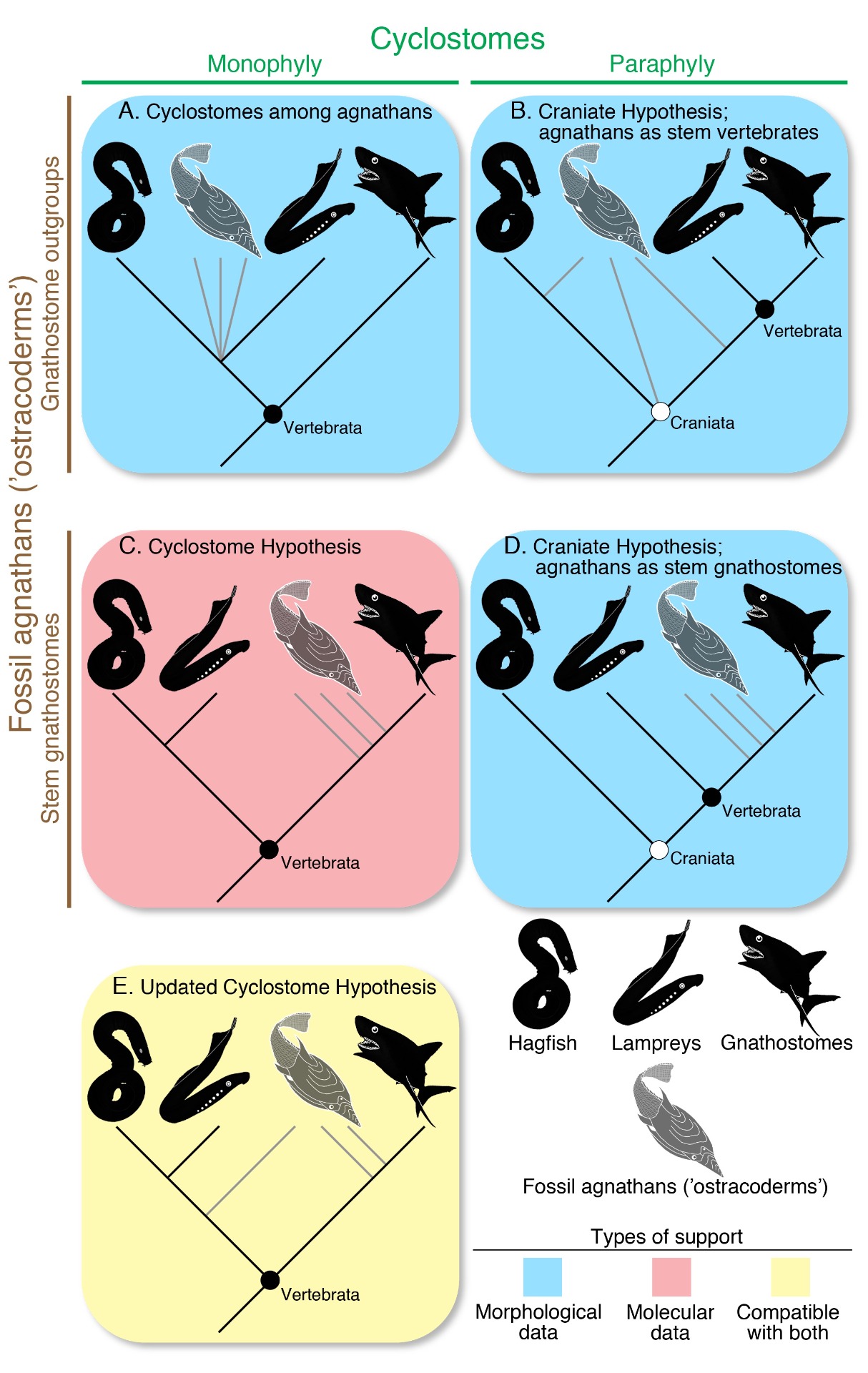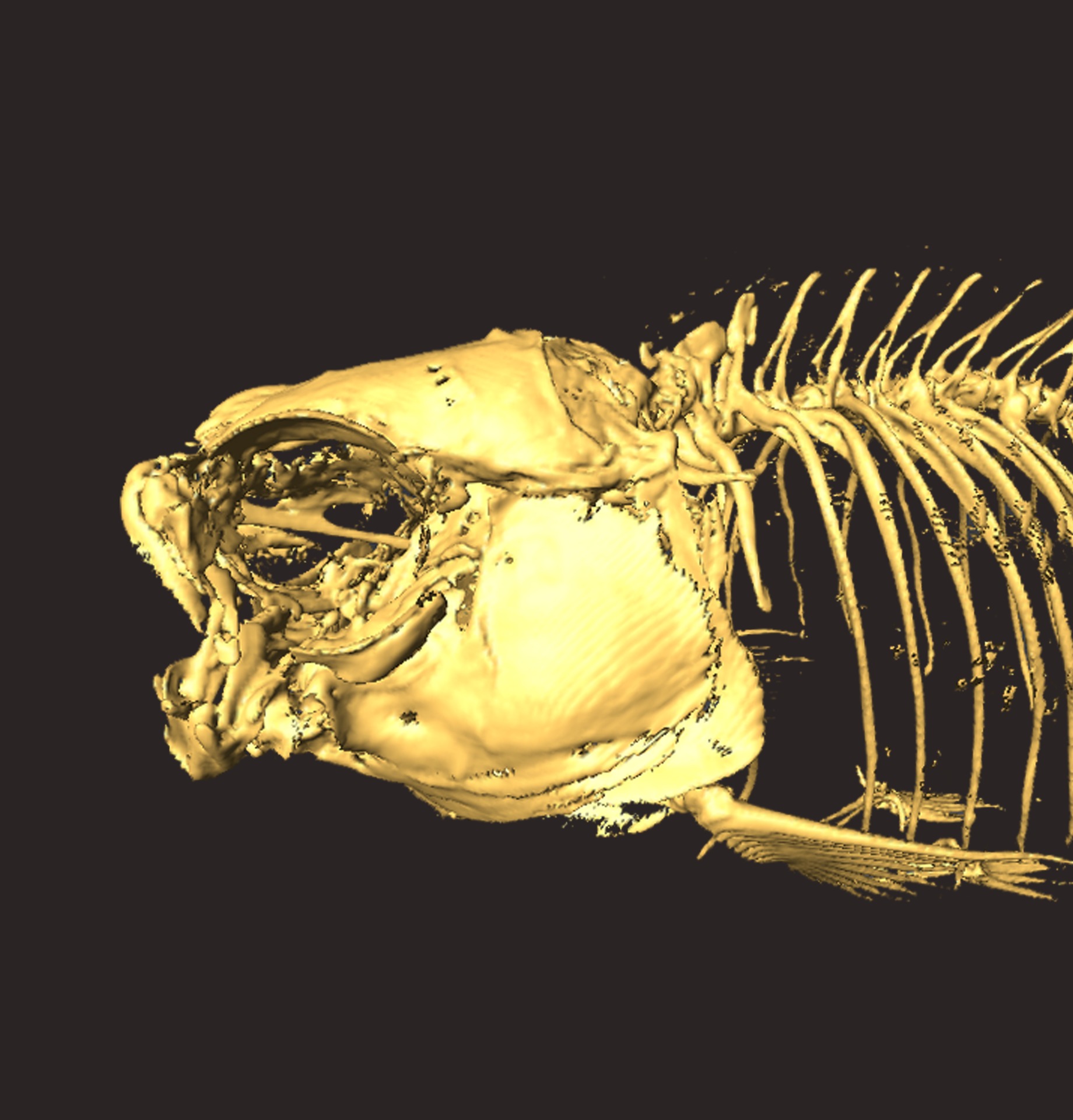— Research at CMN's EvMorph lab —
The lab pursues questions at the interface of palaeobiology, evolution, and developmental biology. PI's special interest falls on Palaeozoic fishes and early events in vertebrate evolution, but the past work covers a broad field from snails to dinosaurs. A common thread connecting a diverse array of animals and a wide range of projects is how we integrate information from fossil record, comparative anatomy, and development, moving seamlessly between fieldwork and lab work. In doing so, we often address unresolved puzzles and conceptual problems, but these endeavors often begin with – and driven by – humble observations and small curiosities.
Vertebrate Origins: Early Evolution of Jawless Fishes
How much about the vertebrate ancestry do the seemingly pritimive fishes tell us?

Jawless, boneless, and virtually without fossil record, hagfishes and lampreys (cylostomes) continue to escape a grip in our effort to understand their evolutionary history. My recent work (2019, PNAS) reconciled conflicting interpretations of their evolutionary relationship, with one surprising twist: their common ancestors likely had a bony armour, implying that modern cyclostomes lost defining vertebrate traits like bone and their apparent primitiveness is secondarily derived.
This reversal poses a serious problem. Modern lampreys have a larval phase that in many ways resemble non-vertebrate outgroups. Therefore this larval phase, and their development, remains a primary model for the vertebrate ancestry. How should we interpret this? Our current work focuses on this question (see Miyashita et al. 2021).
The key to solve these puzzles lies in maximizing information from what little of their long evolutionary history is preserved in fossil record. This takes modern imaging methods (synchrotron scanning), sophisticated phylogenetic approaches, and refined understanding of the developmental biology of cyclostomes.

Developmental plasticity and skeletal remodeling in functionallly jawless zebrafish
What happens when a feeding apparatus conserved for >450 million years becomes disabled?

Jawed vertebrates are, literally, defined by having jaws. No descendants of the first jawed vertebrate ever lost the structure. Any jawless mutant must have quickly fallen out of favour by natural selection.
What would a jawless jawed vertebrate look like? Using genome editing tools, we produced zebrafish in which nkx3.2 –the gene responsible for forming a jaw joint – is rendered non-functional. These mutant fish have jaw skeletons but lack a hinge joint with which to move them.
Mutant fish developed dramatically modified skulls, which occurred as a plastic response, independent from nkx3.2 loss of function. The altered skull shapes resembled those of extinct jawless vertebrates.
These results give us a glimpse into the nature of the phenomena known as phenocopies. Knocking out genes does not reverse the development to an ancestral state. Instead, it creates functional landscape in which plastic responses can lead to parallel, or similar, morphological consequences. We are currently investigating its full evolutionary implications.
Evolutionary Assembly of the Vertebrate Nervous System
"Is the brain powerful enough to solve the problem of its own creation?" – G. Eichele (1992)

Aside from the mouth and pharynx, the head of a vertebrate mostly exists to encapsulate the nervous system and the sensory structures it innervates. A complex brain is a hallmark of vertebrates, and its origin and early evolution constitutes a climax in the narrative of vertebrate evolution. But we know little about how this complexity came about.
In this new direction, the lab teams up with Dr. Christopher Lowe (Stanford University) and former colleagues and mentors from the University of Chicago and California Institute of Technology to make a three-taxon comparison possible: acorn worms (Saccoglossus kowalevskii), lampreys, and zebrafish.
The nervous system is perhaps the most tractable system in the absence of gross morphological similarities. These animals differ greatly in neural anatomy, as the net-like organization in the vertebrate outgroup (acorn worms) is set in a clear contrast with the centrally organized, brainy vertebrates.
Ultimately, the origin of the brain in vertebrates equals the origin of the head, and the early evolution of the central nervous system closely tracks the evolution of the head-trunk boundary. This leads us to the project ver. 2.0 on the rise of jawed vertebrates, which trains light not just on the origin of jaws, but also on the transitions that gave rise to other gnathostome synapomorphies.
The Rise of Jawed Vertebrates: Novelties and Co-options
A great domino of morphological changes in a major evolutionary transition of vertebrates

An evolutionary novelty pushes homology all the way to the conceptual limit. The lab PI proposed a hypothesis about the origin of vertebrate jaws (2016, Biol. Rev.). Although the jaw is generally explained as a secondarily modified pharyngeal segment, the hypothesis postulated an opposite scenario: a distinct head region assimilated repeated patterns in the pharynx.
Whether the hypothesis stands tests or not, this transition is set against a busy background where other major structures appeared, including paired appendages and a complex heart. The lab is interested in unraveling these tight knots of correlated morphological evolution.
Palaeozoic fishes of Canada and the World

Set in the national collections, our mission is to preserve and research Canada's natural heritage through the dazzlingly rich record of Palaeozoic fossil fishes, with important localities spread across the country. Canada is home to many iconic fossils that mark major transitions of vertebrate evolution, from the Cambrian fish Metaspriggina to the Devonian fish-a-pods Tiktaalik and Elpistostege, and the likes of Eusthenopteron and Romundina in between. The lab will go out on a limb to find new localities and new specimens, but will also revisit old ones to bring them under new light.
Meanwhile, the Canadian fossil record means little without global context. The lab will actively pursue international opportunities to parallel efforts with our research at home.
Morphology and Development of [Cool Animals]

Although with a primary focus on early vertebrate evolution, the lab PI remains interested in pursuing and supporting projects that may not readily fall into that specific program. These include the work on dinosaurs that began in my early training with Dr. Philip Currie (University of Alberta). The current collaboration centers on a fine specimen of the tyrannosaur Daspletosaurus (TMP 2001.36.1).
Other projects look into larval arm development in echinoplutei (with Karen Can, Swarthmore College), biomechanics of gastropod shells, morphometrics of sponge spicules, or a preserved brain and stomach contents of an Eocene shark (2016, Zool. Letters). These projects are inspired while in training with Dr. Rich Palmer (University of Alberta).
These projects may appear somewhat distant to the main interest of the lab, but they are an important part of the program. #1 – These projects allow looking at conceptual problems the lab addresses in different dimensions. #2 – They provide a philosophical test: If one can resolve information from just a stain of a fish on a rock slab, one could not do any less with a three-dimensionally preserved mineralized skeleton. The opposite also holds true, as one approach that works for one but not the other tells us about the nature of the problem.
As such, the lab PI would welcome comparative biological approaches to any animals deemed "cool" and would be happy to facilitate support. Interested students should contact.

